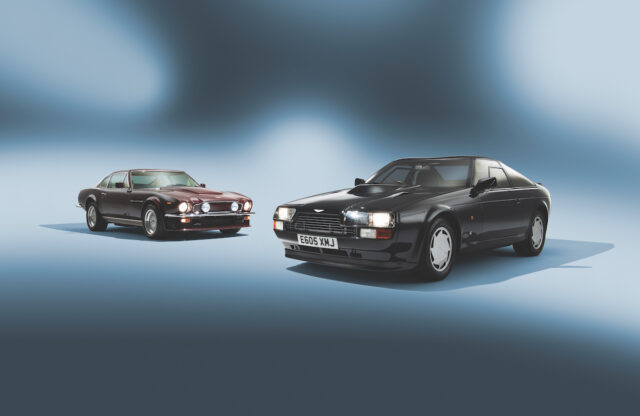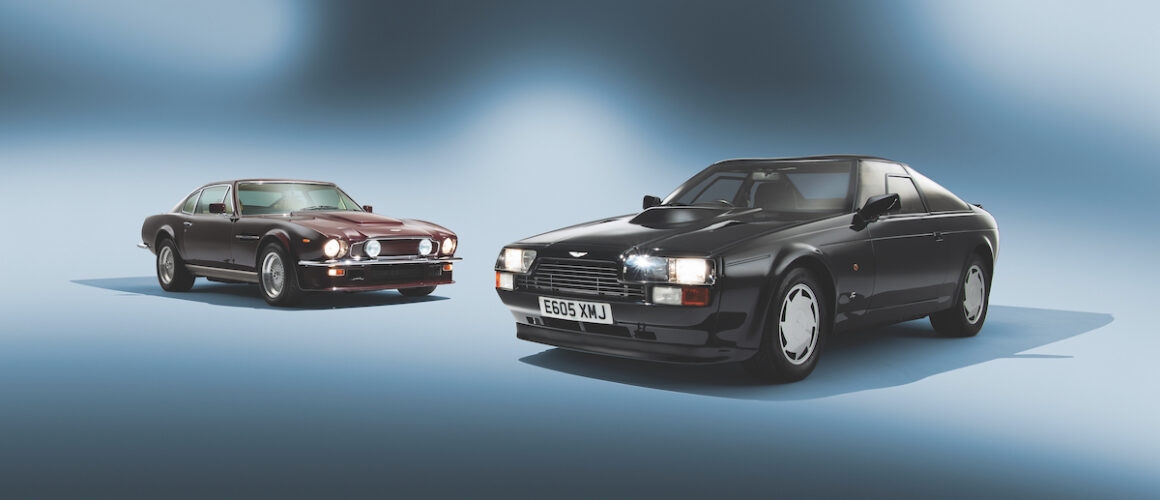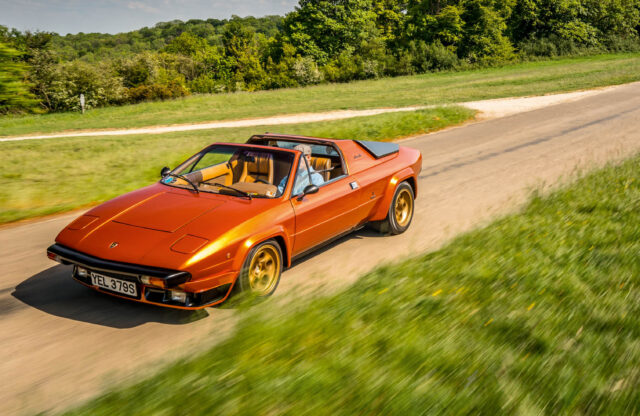The Aston Martin V8 Vantage Zagato has matured from its slightly awkward beginnings. Does that make it a bargain compared with the standard car?
Aston Martin has always made good-looking cars. Since its inception in 1913, when it was founded by Lionel Martin and Robert Bamford, as well as during the Augustus Bertelli years of the late 1920s and with David Brown in the 1950s, Astons not only looked rakish but were also successful in international motorsport, including Le Mans and the Mille Miglia. The ultimate victory was the DBR1 winning the fabled 24 Hours in 1959.
Under David Brown, the DB2 and DB MkIII were beautifully styled by Frank Feeley but, in 1958, Brown went for the full, bespoke Italian design and enlisted Touring of Milan to style the DB4, regarded by many as one of the most elegant cars ever made.
Aston also decided it needed a lighter and more compact version of the already shortened DB4 GT and turned to another Italian carrozzeria: Zagato. It was coachbuilt at the Zagato factory with dramatic styling from the pen of Ercole Spada, and launched at the London Motor Show in October 1960. Initially 25 were planned but only 20 were completed. Stirling Moss drove a Zagato to third place in its first race at Goodwood in 1961, finishing behind another Aston DB4 GT and the winning Ferrari 250 GT.
The famous Zagato ‘2 VEV’ – which featured on the cover of Octane 181 – won its first victory at the British Grand Prix support race in July 1961. A further four factory-approved Sanction II cars were produced in 1989 and sold for more than a million dollars each; 2 VEV was sold earlier this year by Bonhams at the Goodwood Festival of Speed for £10.1 million. A good DB4 GT is worth around £2.5-3.5 million, so clearly the Zagato label carries a significant premium.
And this is also true of later Zagato Aston Martins that followed the DB4, all rare and truly desirable motor cars. A DB7 GT of 2003 is worth around £65,000 but the Zagato version (100 built) is £275,000-325,000. A V12 Vantage of 2011 will set you back £100,000, but the Zagato (150-off) commands £500,000. A 2018 Vanquish is £165,000 while the Zagato variant (99 constructed) is nearer to £800,000.
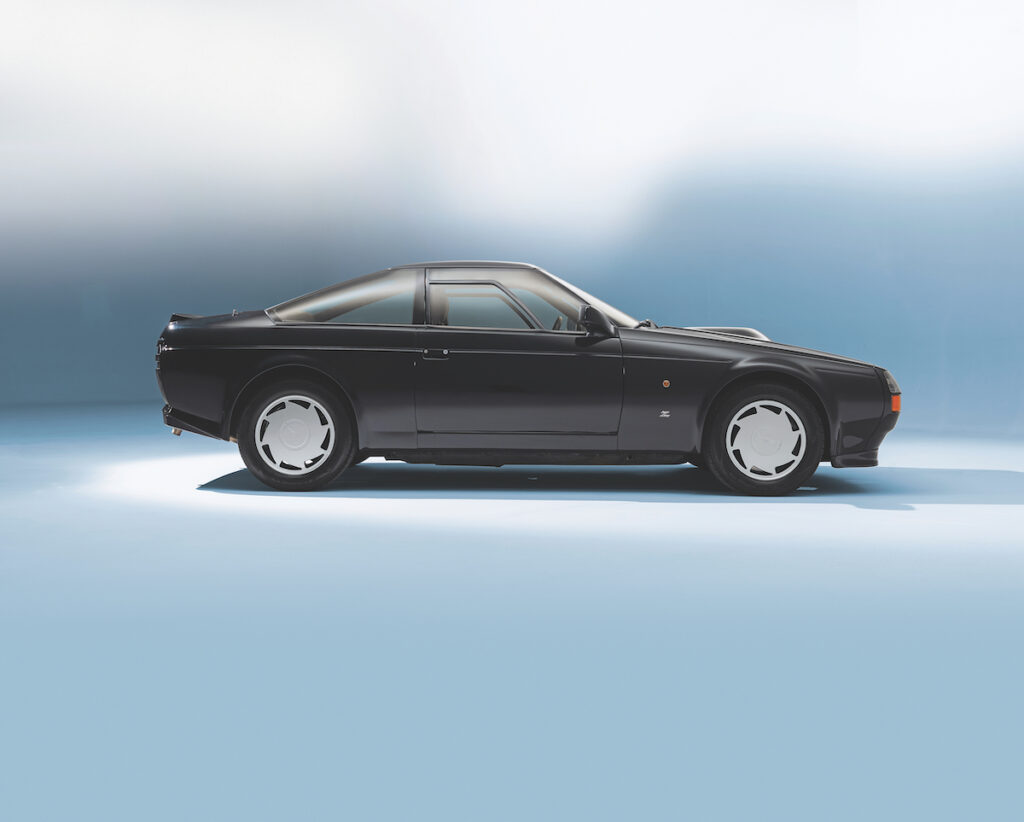
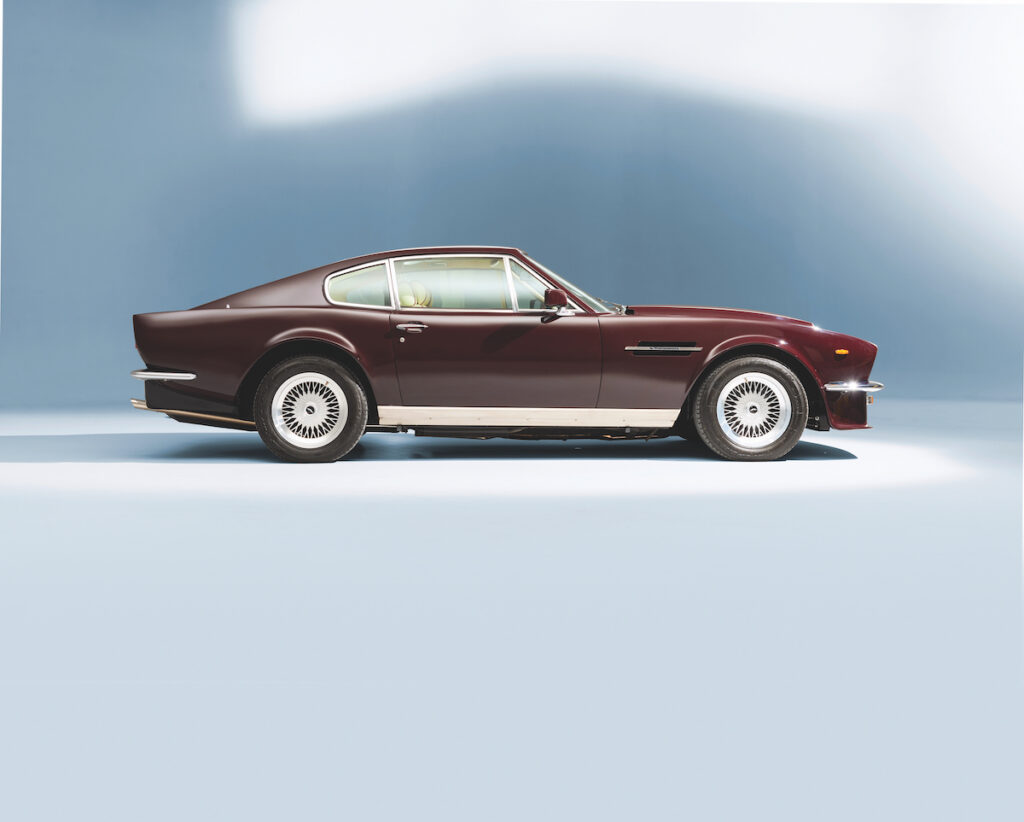
The Zagato protagonist we have here is one of only 52 Aston Martin V8 Vantage Zagatos produced (there were 37 convertible Volante Zagatos as well). It is derived from the standard Aston Martin V8 Vantage you see next to it, of which 429 were built between 1977 and 1989. So, what is the significant premium required for you to be able to park this particular Zagato in your garage? You might be surprised.
But first, let’s take a look at the Vantage upon which this Zagato is based. After the DB4, 5 and 6, the launch of the six-cylinder DBS in 1967 gave Aston Martin a contemporary new look, with curvaceous hips and sharp-edged styling by William Towns. It received the 5.3-litre V8 in 1969 and evolved into the Vantage in 1977, when it was hailed as ‘Britain’s first supercar’.
The quad-cam V8, fed by four Weber 48 IDF/3 carburettors (the previous Lucas fuel injection system had been dumped because Aston couldn’t get it to work reliably), pumps out 400bhp at 5800rpm and 380lb ft at 4000rpm. This is all fed though a five-speed ZF gearbox, with a dogleg shift pattern, and on to the wheels via a limited-slip differential at the rear, which is at the centre of a de Dion layout with Watt’s linkage. The chassis and superstructure are of steel, clothed in handbeaten aluminium panels, and it’s a substantial beast, kept in check by power-assisted rack-and-pinion steering and vented disc brakes.
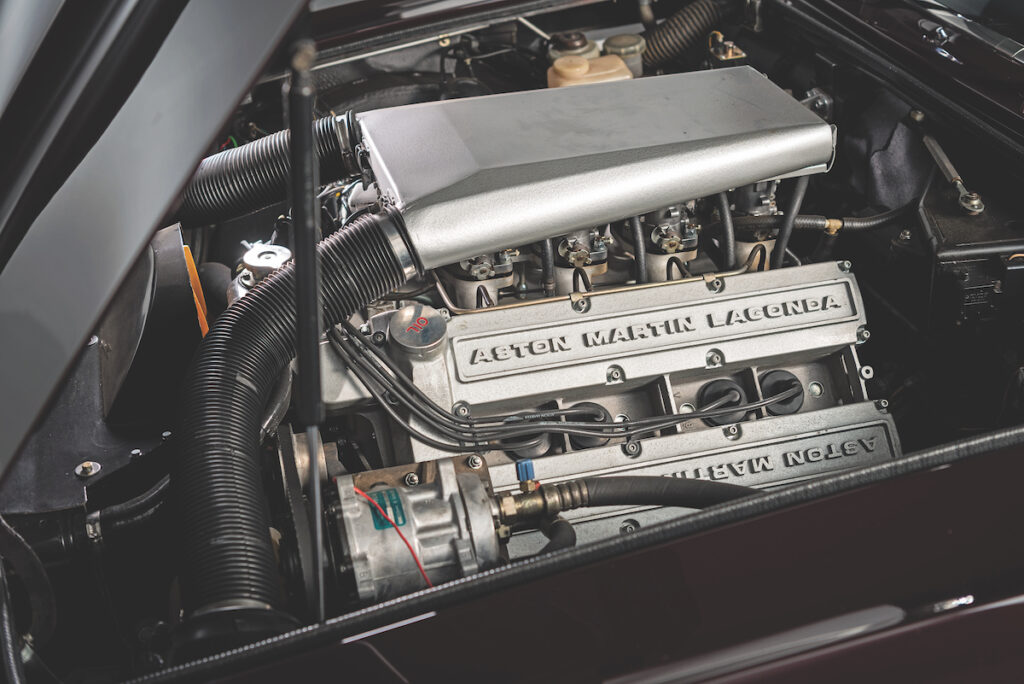
Aston Martin’s boss of the time, Victor Gauntlett, referred to the Vantage as a ‘two-ton brick’. A slight exaggeration because it weighs 1810kg, but it’s still no lightweight. I remember the road test of the Vantage conducted by Motor in 1981. The test car was pale metallic blue and looked like a well-dressed hot rod with that massive front spoiler, huge bonnet bulge, blanked-off front grille, twin Cibie driving lights, kicked-up rear spoiler and chunky alloy wheels shod with fat 255/60×15 Pirelli tyres.
The test drivers exclaimed that the Vantage was ‘Exclusive, exquisite and exhilarating’, and it was ‘…the fastest standard production road car ever tested by Motor, as well as being one of our all-time favourites’. The test figures pinned the top speed at 170mph with a 0-60mph drag in 5.2 seconds. The big Aston outpaced the Lamborghini Countach and Porsche 911 Turbo 3.3 at every measure.
Today we collect the Vantage from specialist Nicholas Mee’s beautiful new premises just north of London. Having worked at Aston Martin for years and establishing Nicholas Mee & Co some 25 years ago, Nick recently relocated from busy London to picturesque Essendonbury Farm on the Hatfield Park Estate. The veritable ‘works’ consists of numerous listed buildings and immaculate dark-painted barns that house all the workshops and service operations. It’s surrounded by some great driving roads and therefore a true destination for Aston lovers; call ahead for the helipad co-ordinates…
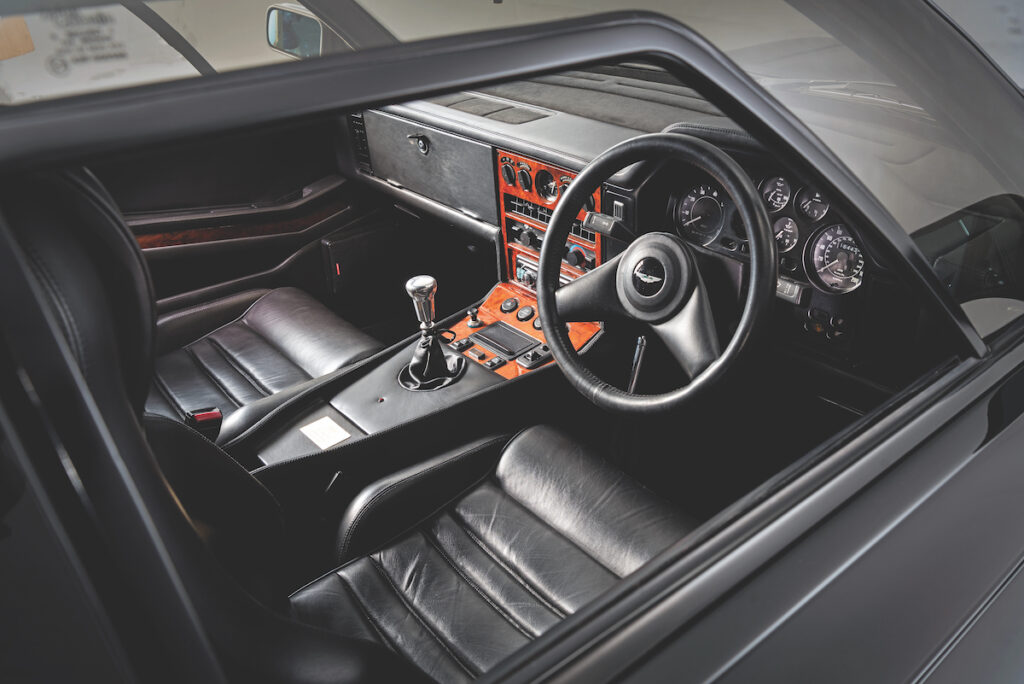
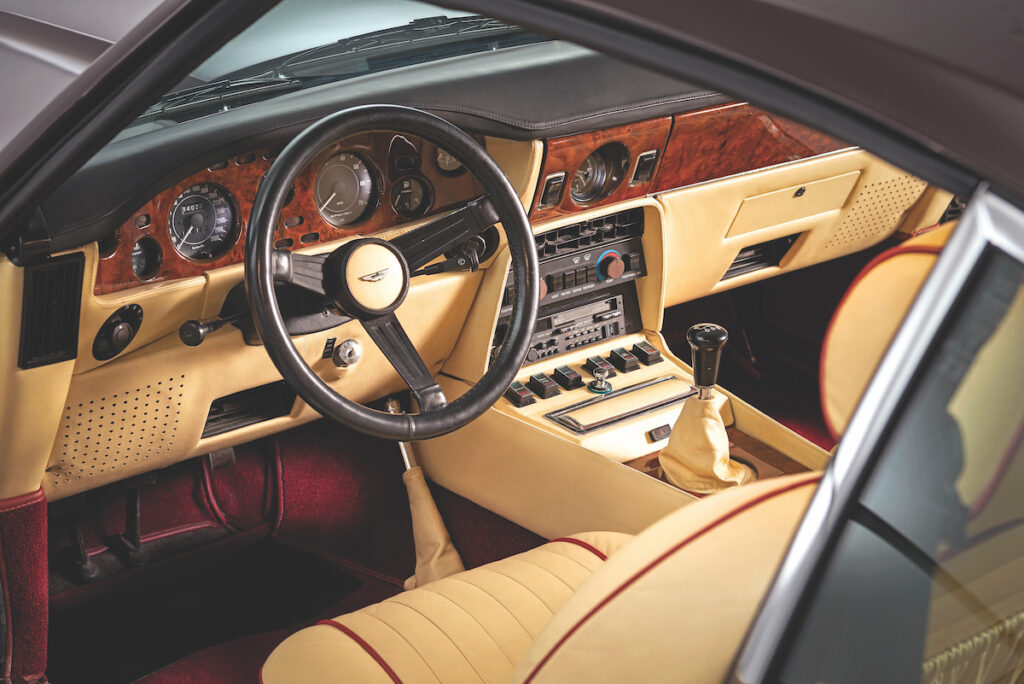
Ready for our enjoyment en route to the studio shoot are this 1984 V8 Vantage in Royal Cherry – and also the 1987 V8 Zagato in Masons Black. Nick actually has three Zagatos in stock (at the time of going to press) and it was he who’d raised the whole V8 Zagato thought for us to explore.
‘All other Aston Zagato models attract a serious premium because they are rare and desirable. The V8 Vantage Zagato is the exception. They are valued at only slightly more than the standard V8 Vantage, which, to my mind, means they are undervalued and therefore worth a close look. I mean, only 52 were ever made at the actual Zagato factory in Italy and they are great cars to drive. In comparison to all other Aston Zagatos, the price differential is nowhere near as marked.’
To be clear, the V8 Vantage here is priced at £399,950 and the Zagato at £495,000. Also available at Mee’s operation is actor and former Octane columnist Rowan Atkinson’s race-prepared Gladiator Red Zagato at £495,000, which boasts 482bhp along with serious weight-saving – though that’s an entirely different proposition!
Best to start with the V8 Vantage as the benchmark. One of 127 built in this spec, this immaculate example has been restored by Aston Martin Works, including an engine upgrade to later X-Pack specification. It’s a big car – 6ft wide and 15ft long – that seemed vast when it was launched, but that was in pre-SUV days and it remains a classically elegant GT. In Vantage spec, the added spoilers, driving lights and large alloys add a look of menace. Within, the parchment hide trim is elegant and trad-Brit: Connolly leather, Wilton carpeting, walnut dash and very comfortable seats that allow good visibility over the bonnet hump.
Yet although it is beautifully clothed inside and out, the big Aston promises real muscle and a massive punch. Start-up technique is the same as with any Weber-fed engine: dab the throttle a few times and hold it part-open. The V8 fires easily and idles steadily and –goodness! – it produces a rich cacophony of overlaid sounds: whirring cams and chains, low-speed Weber-carb gobble and a lovely, three-dimensional exhaust rasp.
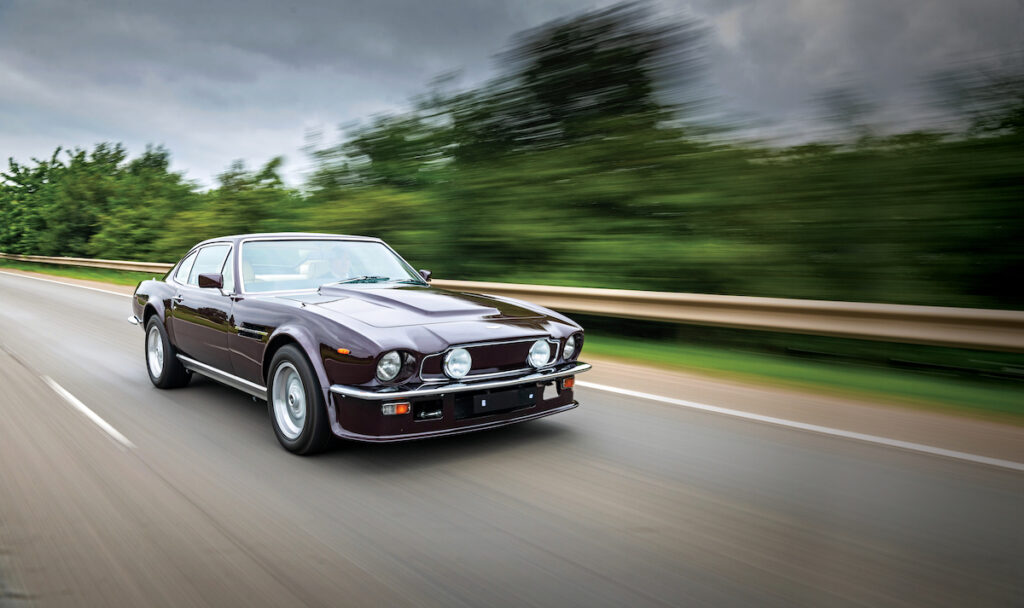
This being a left-hand-drive example, the gear-shifter is worked with your right hand and first is towards you and back on the dogleg – actually much better and more intuitive this way. The clutch is firm, as you’d expect, and the gearshift action is long of throw, not particularly precise and somewhat agricultural. Importantly, it does the job better as speed increases.
Similarly the V8, which has loads of torque, but with all those camshafts, and the extremely large brass butterflies within the mighty Weber carbs, is happier with at least 2000rpm on the revcounter. Initially, driving the big Vantage through the narrow country lanes of Hertfordshire requires discretion as this valuable car is in such perfect condition. The ride is firm yet pliant, but you need to keep on the steering as the cambered lanes make the Vantage want to move about on its wide tyres. At normal pottering speeds the engine is obedient but the car does not feel entirely content – too big, hard and powerful for these back-roads.
And there’s a fast section of B-road ahead: enter the roundabout, drop the lever down into second and ease some pressure onto the throttle linkages. The big V8 spins-up in a trice; this is not a lazy lugger, instead it’s a serious revver and reacts with an instant snarl. Four thou’ on the revcounter and the engine hits its sweet spot. The roundabout suddenly becomes a slalom as the tail slews outwards and the de Dion rear end and limited-slip diff fight to control the torque. Inevitably, they lose.
Oops, steady on and calm down. Lift off a bit, get the Aston’s trajectory going straight ahead once out of the roundabout, then plant it again. The big bus squats down and veritably catapults itself down the dual-carriageway. Snatch third, fourth then fifth; these higher ratios are so nice and close, and this bruiser is now in its element, howling towards the horizon.
Big, heavy, powerful, blunt, muscular, thunderous, indefatigable, the Aston Martin V8 Vantage is certainly all of these. But the 5.3-litre quad-cam V8 is what makes it so special. The handling, deportment, braking and so on are all just fine: meat and two veg. The Vantage is not the sharpest tool in the GT box but that engine, with the builder’s name proudly displayed on a plaque, is an automotive artform. It is, simply, one of the best engines going.
Sure, today’s modern high-performance powerplants produce bigger and more efficient specific outputs, but they are in essence just petrol-powered pumps to feed electronically controlled forced-induction blowers. The Aston’s brawny V8 is an ode to joy. You can tell it’s a big unit by the mighty slap it administers to the tarmac, but it is unexpectedly sweet as you lay on the juice – and gets smoother and more sonorous as the revs rise, just like the best engines from Maranello and Stuttgart.
You have two options: open a bottle of your favourite Claret, light a Montecristo No 4, dig out Beethoven’s Fifth from your Deutsche Grammophon box collection, ease the needle onto the vinyl, wind the volume full right, and sit back. Or you can take an Aston Martin V8 Vantage out for a blast. I concede that I’m now waxing lyrical, but this is the whole point of really good classic cars. The handcrafted quality can be felt through the seat of your pants and it remains special. It’s not simply down to outright speed and acceleration; it’s the quality of the delivery that’s to be savoured and here the big Aston aces it.
With the Vantage having impressed so much, it’s time to try the Zagato. How did the idea germinate? Back in the day, Aston Martin chairman Victor Gauntlett said: ‘I was at the Geneva Motor Show in 1984 with co-owner Peter Livanos and we saw everyone was like bees around a honeypot looking at the GTO on the Ferrari stand. We then walked past the Zagato stand and that triggered it off.’
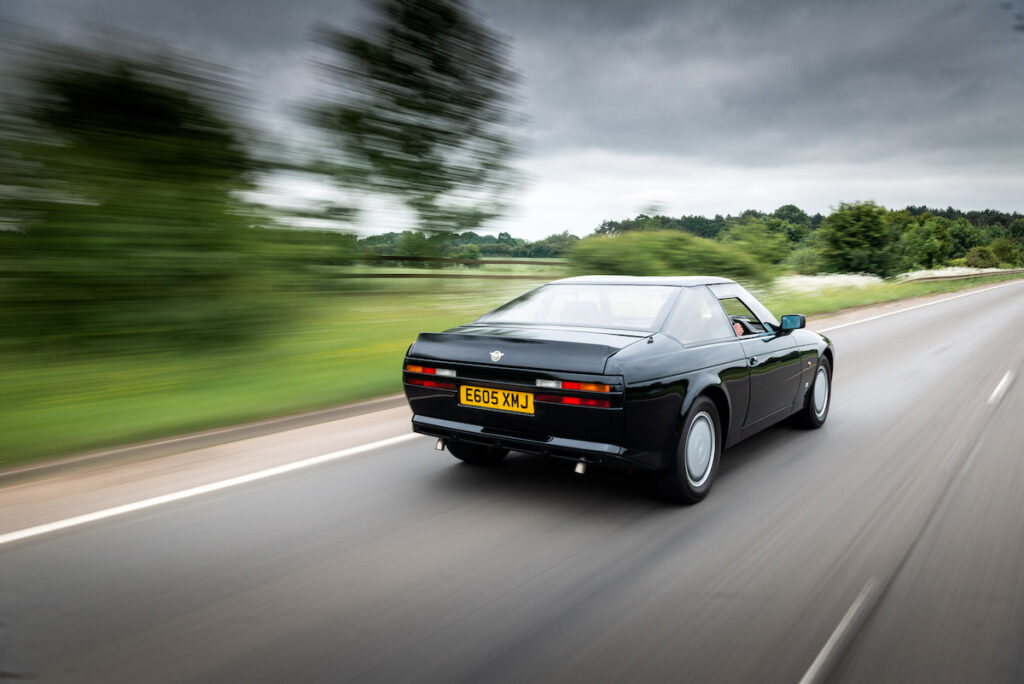
Offering V8 Vantage underpinnings, Gauntlett and Livanos commissioned brothers Elio and Gianni Zagato to create a supercar that was to be capable of 300km/h and have a 0-60mph sprint time under five seconds. With added power – 432bhp thanks to 50mm chokes, big-bore exhaust and airbox versus the Vantage’s 400bhp – plus a loss of some 180kg in weight, a 10.6in chop behind the rear wheels, and a drag co-efficient of 0.31 compared with something so house-like it wasn’t quoted, it sounded like a good idea. The Zagato’s final drive was raised from 3.33:1 to 3.06:1. Wheels were changed to Speedline alloys shod with 255/55 VR16 Goodyears. The alloy coachwork was advanced, with flush-fitting glass and pop-out front and rear bumpers. Here, the apocryphal story goes that, when asked about damage to these supposed ‘pop out’ bumpers, Victor Gauntlett replied: ‘Yes, pop out to the works and we will replace them.’
A batch of 50 Zagatos was put into production and all were sold ‘off-plan’ before an alloy panel was so much as kissed by a hammer or a dolly. Priced at a whopping £87,000, when the standard Vantage was £59,000, the exciting Zagato was the new supercar on the block. It was launched at the 1986 Le Mans 24 Hours, the PR idea to do a full-blast demo run in front of the large crowd of enthusiasts, topping out at 186mph. But the car suffered fuel feed problems and rather embarrassingly fell way short. Pride was restored a week later when a French journalist managed 185.5mph and 0-60mph in 4.8 seconds on an (allegedly) closed section of the autoroute.
So the new Aston Martin Zagato had landed, son of the previous, magnificent-looking DB4GT Zagato – to an equal extent faster, lighter, more focused than the standard Vantage, but… a visual challenge. Oh dear.
Up against the sexy Ferrari 288 GTO and the curvaceous Porsche 959, the Aston looked more like a minicab than a supercar, short and dumpy, its lumpy bonnet bulge a carbuncle, with a truncated bobtail rear, and sitting on alloys that could have come from an accessory shop. Zagato has a history of wonderfully weird and attractively eccentric styling but this wasn’t it. Many buyers were disappointed and, once these cars had been through the ‘flipping’ frenzy before the 1990s crash, values tanked.
But styles and fashions change and, 32 years later, the Vantage Zagato has aged rather well. The flush-fitting glasshouse is cleverly resolved and the coachwork is as smooth as a sucked lozenge, as is the styling wont of today. This one looks tasteful and understated, which is a pleasant change from the looks of most brash supercars. As with a Bristol 404 or an Audi Sport Quattro SWB, only the informed few will notice the V8 Vantage Zagato.
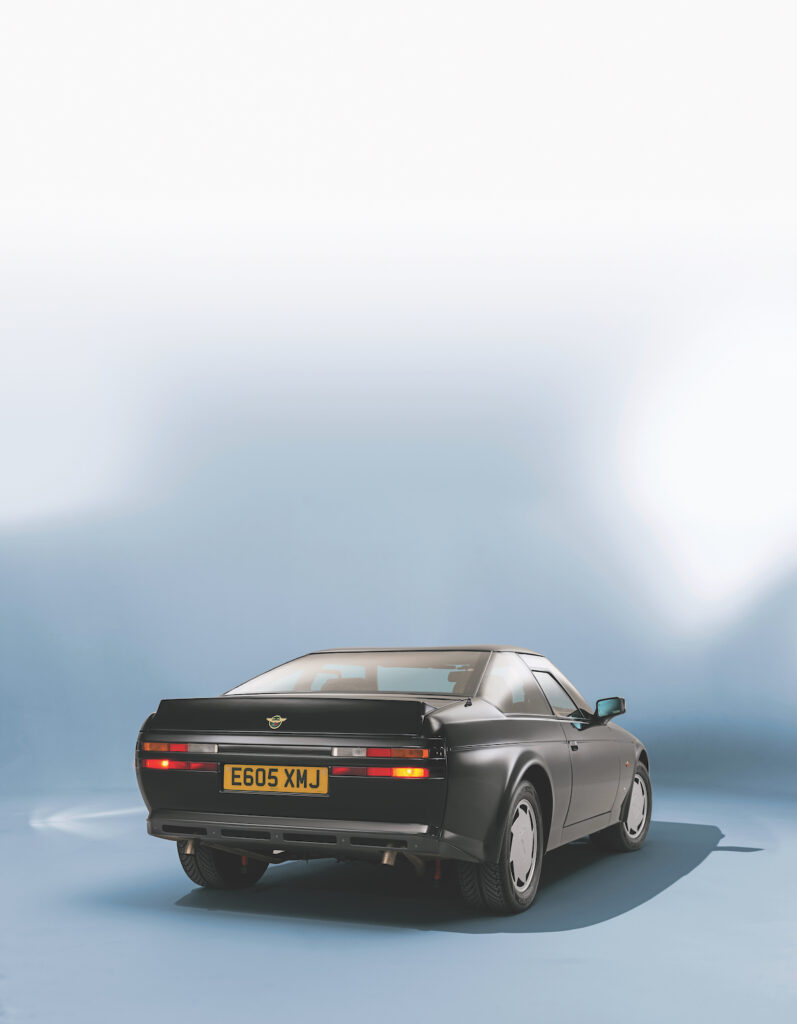
Unlike the gentleman’s club interior of the Vantage, the Zagato’s cabin is 1980s sports-car perfunctory: more focused, more modern, yet still exquisitely trimmed. And it is airy, with thin pillars offering good sightlines, and it is capacious for two. Even though they are slender in the cushion, you sit quite high on the well-formed Zagato bucket seats.
Fire up the 5.3 and you’re met with a malevolent roar thanks to the expanded Webers and bigger exhausts. Clear the carbs and savour the big lump’s potent but creamy reaction to the throttle. Push the gearlever away and back for first and the difference between this Zagato and the Vantage is immediate within a few yards. The longer gearing, lighter weight and added power are instantly noticeable. Get it rolling, then give it the beans in first – it’s good for 60mph – and you realise that this is a different kettle
of aluminium-tinned fish.
Across the gate into second – a bit slow in action – then hard on the throttle, the Zagato spins its LSD-controlled wheels and lunges forwards, feeling light, sharp and bloody fast. The heavy power-assisted steering lightens up and the tightly stacked gear ratios translate all the thrust to the road as the Zag assumes attack mode.
All I can write, once again, is, ‘Oh dear’: this tightly coiled lightweight has just rendered the lovely classic Vantage an anachronism. The Zagato’s responses are athletic, if not balletic, but it makes the Vantage seem like a lumbering heavyweight.
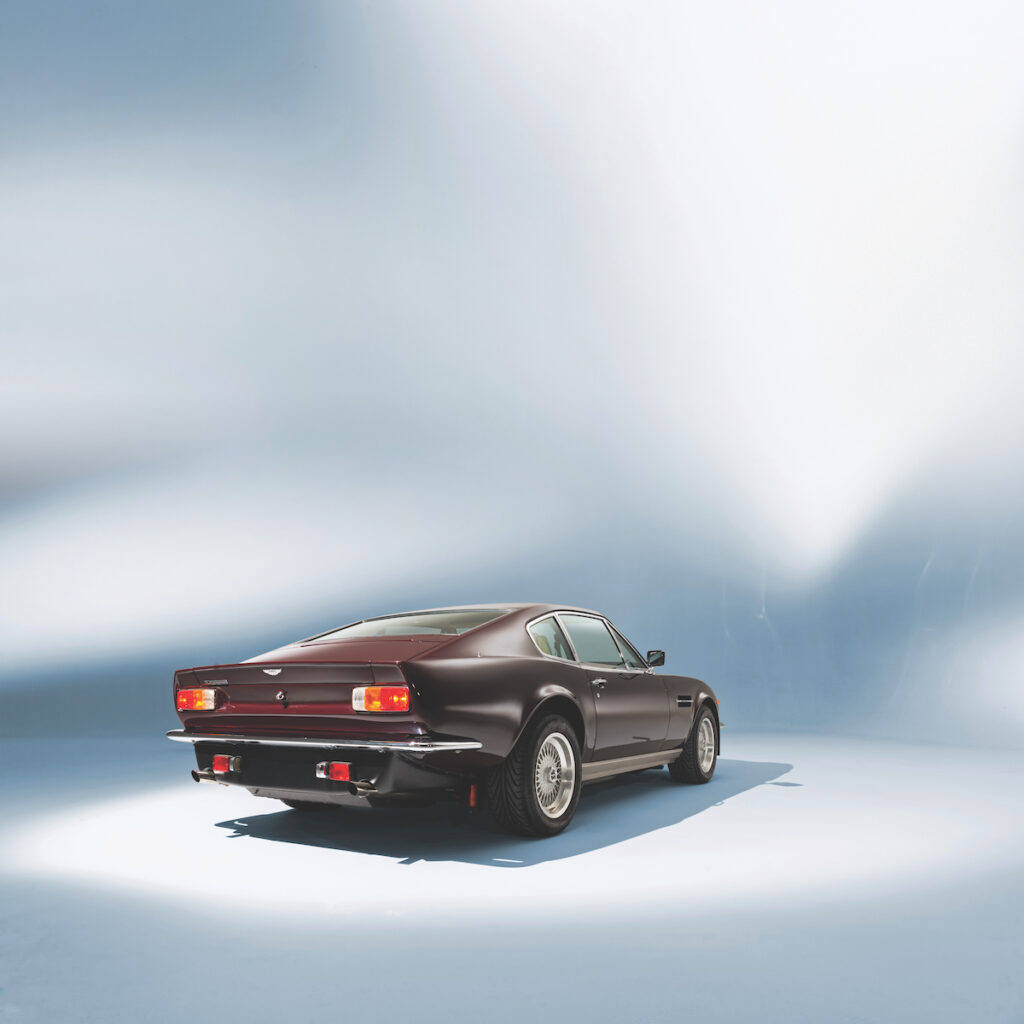
The engine response is harder, sharper, keener, with the redline moved up to 6250rpm, and the chassis is more than a match for it. The Zagato feels flat and balanced even though the weight distribution has shifted from 51:49 to 58:42 front-to-rear, yet with the de Dion rear axle geometry keeping the wheels upright and the bodyweight reduced by 10%, the car is more of a sharp-jab punch in operation than a roundhouse haymaker. It’s more reactive, tighter and better to drive than the regular Vantage, with less dialled-in understeer: a full-on supercar in which that magnificent engine makes the most of a suitably enhanced package to deliver its full potential.
You know the old ‘more than the sum of its parts’ adage? The Zagato really is a case in point. To think that it is essentially the same car underneath as the rumbustious Vantage is hard to comprehend. It couldn’t be so much better… and yet it is. The driving experience is so different; you really can chuck it about with one hand on the wheel.
Nicholas Mee is on to something here. Aston Martin Zagatos are very special indeed, it’s just that the V8 Vantage Zagato has never been as much appreciated as the rest. Having driven a Ferrari 288 GTO (I found its flick-switch turbocharged nature tricky) and a Porsche 959 (it was a tour de force in its time, yet it is now much like any modern 911), I find that the Aston Martin V8 Vantage Zagato, in comparison, has bottle-matured into something beguiling.
Given the choice I’d take the Zagato and enjoy its astonishing yet manageable analogue performance in preference to the other two. And if a punter hailed me down as a minicab… well, they’d be in for the ride of their lives.
Factfile – 1987 Aston Martin V8 Vantage Zagato (and 1984 V8 Vantage)
Engine 5340cc alloy V8, DOHC per bank, four twin-choke Weber IDF3 carburettors Power 432bhp @ 6250rpm (400bhp @ 5800rpm)
Torque 395lb ft @ 5100rpm (380lb ft @ 4000rpm) Transmission Five-speed ZF manual, rear-wheel drive, LSD Steering Rack and pinion, power-assisted Suspension Front: double wishbones, coil springs, telescopic dampers, anti-roll bar. Rear: de Dion axle, trailing arms, coil springs, telescopic dampers, Watt’s linkage Brakes Vented discs Weight 1640kg (1820kg) Top speed 186mph (170mph) 0-60mph 4.9sec (5.2sec)
This article was originally published in Octane 186, December 2018
